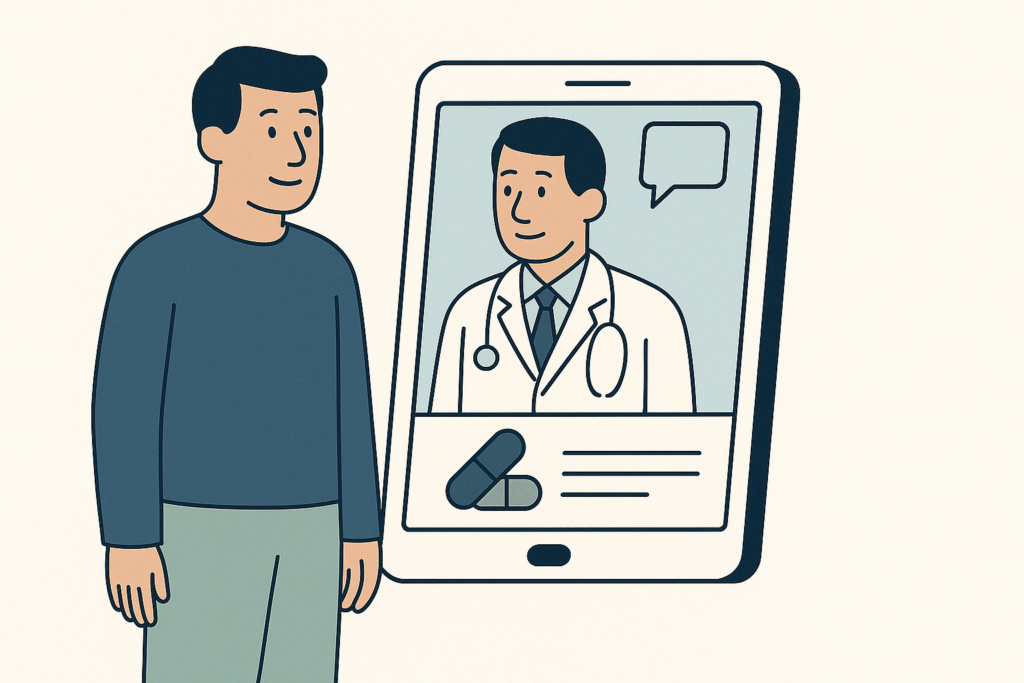Overview
Virtual healthcare offers five essential benefits: convenience and accessibility, reduced exposure to illness, cost-effectiveness, improved continuity of care, and expanded access to specialists, collectively transforming modern medical care delivery. These advantages make online doctor visits not just a convenient alternative but often a superior option for many medical needs, creating a more accessible and efficient healthcare experience while maintaining quality care.
Table of Contents
Introduction
The healthcare landscape has undergone a remarkable transformation in recent years, with telehealth emerging as a cornerstone of modern medical care. What was once considered an alternative option has now become mainstream, with millions of patients experiencing their first online doctor visit. This digital revolution in healthcare delivery has fundamentally changed how patients interact with medical professionals, breaking down traditional barriers to quality care.
At Dr. Telx, we’ve witnessed firsthand how virtual healthcare solutions have opened doors for patients who previously struggled to access timely medical attention. From busy professionals to rural residents, the ability to connect with healthcare providers through secure video platforms has proven transformative for countless individuals.
As we explore the world of virtual healthcare, five essential benefits stand out that make online doctor visits not just convenient but often superior to traditional in-person appointments for many medical needs. These advantages have been consistently highlighted in healthcare research and analysis across multiple patient demographics.

Convenience and Accessibility
Perhaps the most immediate advantage of virtual healthcare is the unprecedented convenience it offers. Gone are the days of arranging transportation, navigating traffic, searching for parking, and sitting in waiting rooms. With online doctor visits, care is literally at your fingertips.
This accessibility is revolutionary for multiple groups of patients. For rural communities, where the nearest specialist might be hours away, virtual visits eliminate prohibitive travel requirements. Similarly, patients with mobility challenges, whether due to age, disability, or chronic conditions, can receive care without the physical strain of traveling to a medical facility.
The flexibility of appointment scheduling with virtual healthcare also deserves mention. Many telehealth providers, including Dr. Telx, offer extended hours beyond the traditional 9-to-5 window, enabling patients to seek medical advice in the evening or on weekends. This is particularly valuable for working individuals who would otherwise need to take time off for medical appointments.
One patient recently shared with us: “Living 45 minutes from the nearest doctor’s office, with unreliable transportation, I often delayed seeking care. Now, I can speak with my doctor from home, which has completely changed how I manage my health.
Reduced Exposure to Illness
The COVID-19 pandemic highlighted another critical benefit of virtual healthcare: minimized exposure to contagious illnesses. Traditional medical waiting rooms can unintentionally become transmission points for various conditions, from the common cold to more serious infections.
For immunocompromised patients, pregnant women, elderly individuals, and others at higher risk, this reduction in exposure is particularly significant. Virtual visits provide a safe alternative that eliminates the risk of picking up an illness while seeking treatment for an unrelated condition.
During flu seasons and other outbreaks, telehealth appointments help reduce community spread by allowing potentially contagious patients to receive care without exposing others. This public health benefit extends beyond individual protection to community wellbeing.
As one immunocompromised patient noted: “Before telehealth, every doctor’s appointment meant weighing the benefits of medical care against the risk of exposure to illness. Virtual visits have eliminated that anxiety entirely.

Cost-Effectiveness
Virtual healthcare generally offers significant cost advantages compared to traditional in-person visits. For patients, these savings come from multiple sources. Direct costs like copays and consultation fees are often lower for telehealth appointments, with many insurance companies now providing equal or preferential coverage for virtual visits.
The indirect savings are equally important. Patients save on transportation costs, whether that’s gas, public transit fares, or rideshare expenses. Additionally, reduced time away from work translates to fewer lost wages for hourly workers or conserved paid time off for salaried employees.
A typical in-person primary care visit might cost $150-300 before insurance, while comparable virtual visits often range from $50-150. When factoring in the additional savings on transportation and time, the economic advantage becomes even more apparent.
Healthcare providers also benefit from reduced overhead costs, allowing many practices to offer more affordable care options. This economic efficiency creates a win-win situation that maintains quality while improving affordability.
Improved Continuity of Care
Virtual healthcare excels at facilitating consistent, ongoing medical care – a critical factor in managing chronic conditions and ensuring positive health outcomes. The ease of scheduling follow-up appointments virtually significantly improves patient compliance with recommended care plans.
The integration of telehealth platforms with electronic health records and patient portals creates a seamless experience where patients can review their care instructions, medication lists, and test results while communicating with their healthcare team. This digital continuity helps prevent information gaps that can occur between in-person visits.
For chronic condition management, the ability to have more frequent, shorter check-ins with healthcare providers is particularly valuable. Rather than waiting for quarterly in-person appointments, patients can touch base monthly or even weekly without disrupting their lives, allowing for more responsive adjustments to treatment plans.
One patient managing diabetes shared: “Through regular virtual check-ins, my doctor catches small changes in my condition before they become serious problems. This proactive approach has helped me maintain better control of my blood sugar than ever before.

Access to Specialists
Perhaps one of the most revolutionary aspects of virtual healthcare is how it democratizes access to specialist care. In traditional healthcare models, patients in smaller communities often travel significant distances to consult with specialists, sometimes facing months-long wait times.
Telehealth breaks these geographical barriers, allowing patients to connect with specialists regardless of location. This is particularly valuable for rare conditions where expertise may be concentrated in specific medical centers.
The efficiency of virtual consultations also typically reduces wait times for specialist appointments. Without the constraints of physical office space and with the ability to see patients from wider geographical areas, many specialists can accommodate more consultations through telehealth platforms.
We recently worked with a patient with a rare autoimmune condition who connected virtually with a specialist 300 miles away. The patient received expert guidance within days, rather than waiting months for an in-person appointment that would have required significant travel and accommodation expenses.
Entrepreneurs and innovators have recognized this tremendous opportunity, launching digital health companies that specialize in connecting patients with hard-to-access specialists across numerous medical fields.

Conclusion
The five essential benefits of virtual healthcare – convenience and accessibility, reduced illness exposure, cost-effectiveness, improved continuity of care, and expanded access to specialists – collectively represent a fundamental improvement in how healthcare can be delivered in the modern era.
As we look toward the future, virtual healthcare will continue to evolve, with advancements in remote monitoring technology, artificial intelligence diagnostics, and integrated care systems further enhancing the patient experience. At Dr. Telx, we’re committed to remaining at the forefront of these innovations while maintaining our focus on personalized, compassionate care.
While virtual visits aren’t appropriate for every medical situation – emergencies and conditions requiring physical examination will always necessitate in-person care – they offer an invaluable complement to traditional healthcare delivery. The ideal approach for most patients is likely a hybrid model, utilizing virtual care when appropriate and in-person visits when necessary.
We encourage you to explore how virtual healthcare options might enhance your medical care experience. Whether you’re managing a chronic condition, seeking specialist consultation, or simply looking for more convenient primary care, telehealth solutions may offer advantages you haven’t yet considered.
Remember, quality healthcare shouldn’t be limited by geography, mobility, or scheduling constraints. With online doctor visits, it doesn’t have to be.
Ready to see how virtual healthcare can streamline your clinic’s operations and elevate patient care? At Dr Telx, we specialize in providing seamless telehealth solutions for providers and businesses looking to stay ahead in the digital healthcare space. Whether you’re looking to enhance convenience, expand access to care, or simplify your consult and fulfillment process, we’re here to help.
Book a Demo today and discover how easy it is to integrate powerful, compliant virtual care into your practice.
Frequently Asked Questions
What conditions can be treated through an online doctor visit?
Many conditions can be effectively addressed through virtual healthcare, including common illnesses like colds, flu, allergies, and sinus infections; chronic condition management for diabetes, hypertension, and asthma; mental health concerns such as anxiety and depression; skin conditions that can be visually assessed; and follow-up appointments to discuss test results or medication adjustments. However, emergency situations, conditions requiring physical examination or procedures, and certain complex diagnoses still require in-person care.
Is an online doctor visit covered by insurance?
Yes, most insurance plans now cover online doctor visits, especially since the COVID-19 pandemic prompted widespread adoption of telehealth services. Many major insurance providers offer equal coverage for virtual and in-person visits, though coverage specifics can vary based on your plan, the telehealth provider, and the type of service. To confirm coverage, check with your insurance provider about telehealth benefits and any specific in-network virtual care platforms they partner with.
How do I prepare for my first virtual healthcare appointment?
To prepare for your first online doctor visit, first test your technology (device, camera, microphone, and internet connection) before the appointment. Find a quiet, private, well-lit space where you won’t be interrupted. Have a list of your current medications, symptoms, questions, and any relevant medical history ready to discuss. If applicable, gather data like recent blood pressure readings, blood sugar levels, or temperature. Finally, be prepared to show any visible symptoms (like rashes) via camera if needed, and have your pharmacy information available in case prescriptions are ordered.
Are online doctor visits as effective as in-person appointments?
Research shows that for many conditions, online doctor visits are comparably effective to in-person care, with similar diagnostic accuracy and treatment outcomes for appropriate cases. Virtual visits excel for conditions that can be diagnosed through visual examination and detailed history-taking. Patient satisfaction rates for telehealth are consistently high, with studies showing effectiveness rates of 85-95% for suitable conditions. However, virtual care has limitations for conditions requiring physical examination, lab work, or procedures. The most effective healthcare often combines both virtual and in-person care as appropriate for each situation.
How secure and private are virtual healthcare appointments?
Legitimate telehealth providers use secure, HIPAA-compliant platforms with end-to-end encryption to protect your privacy during online doctor visits. These platforms offer significantly more security than standard video chat applications. Healthcare providers are required to maintain the same confidentiality standards for virtual appointments as they do for in-person care. To ensure maximum privacy, patients should use secure internet connections (not public Wi-Fi), password-protected devices, and conduct appointments in private locations. Before your first appointment, you can ask your provider about their specific security measures and privacy policies.

